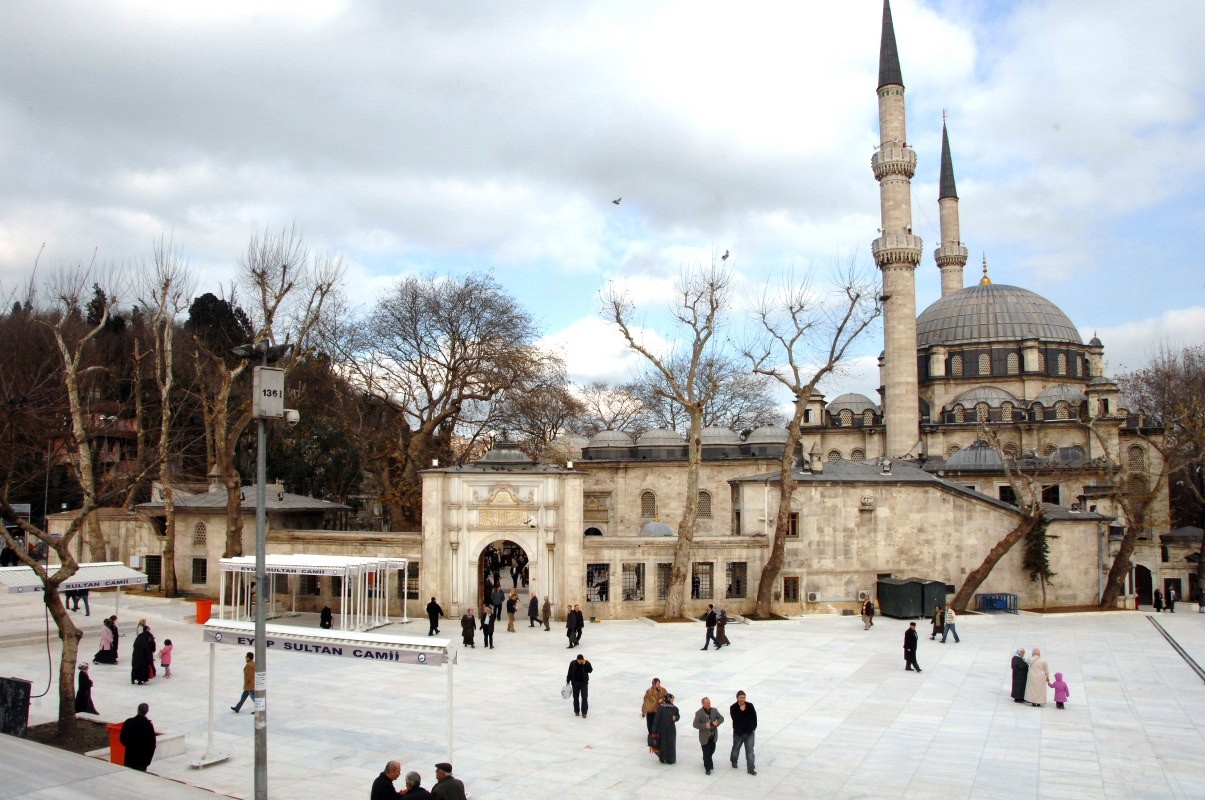
The Eyup Sultan Mosque, also known as the Eyup Mosque or Sultan Eyup, holds a special place in the hearts of both locals and visitors. It is believed to be the final resting place of Abu Ayyub al-Ansari, a companion of the Prophet Muhammad. Abu Ayyub al-Ansari played a crucial role in the early Islamic community and was one of the few who had the honor of hosting the Prophet during his migration to Medina.
Table of Contents
The Legend of Abu Ayyub al-Ansari
Abu Ayyub al-Ansari’s legacy is deeply intertwined with the history of Islam. As a close companion of the Prophet Muhammad, he was involved in significant events that shaped the early Muslim community. His hospitality towards the Prophet during the migration from Mecca to Medina is celebrated in Islamic history, marking him as a revered figure whose presence is felt throughout the mosque.
Establishment Post-Conquest
The mosque was built in the late 15th century, shortly after the conquest of Constantinople by the Ottoman Empire. Sultan Mehmed the Conqueror ordered its construction to honor Abu Ayyub al-Ansari, who was buried in the area. This was a period marked by the transformation of Constantinople into a vibrant Islamic hub, with the Eyup Sultan Mosque emerging as a symbol of this new era.
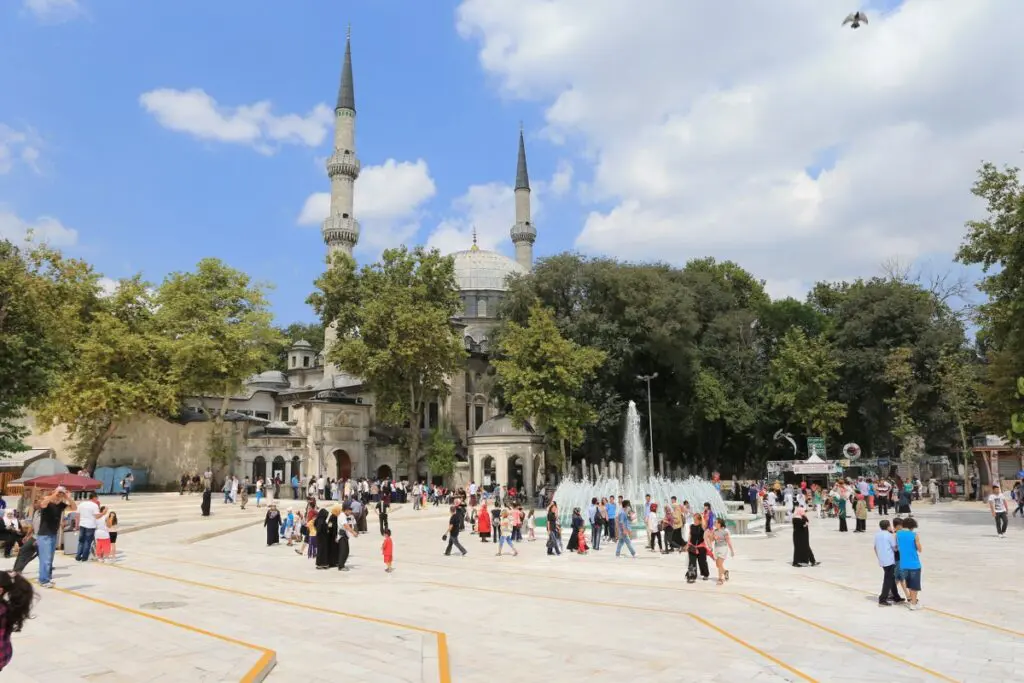
Early Pilgrimages and Devotion
From its inception, the Eyup Sultan Mosque became a focal point of pilgrimage. Muslims from various regions traveled to pay homage to Abu Ayyub al-Ansari, seeking spiritual solace and connection. The mosque’s early days were characterized by the influx of pilgrims who contributed to its growing prominence as a center of Islamic devotion.
Architectural Marvels of Eyup Sultan Mosque
The Eyup Sultan Mosque is an architectural masterpiece that showcases the artistic prowess of the Ottoman era. Its design reflects a blend of Islamic and Ottoman architectural styles, making it a visual delight for visitors.
The Main Courtyard
Upon entering the mosque, visitors are greeted by a spacious courtyard surrounded by elegant arcades. The courtyard is a tranquil space where worshippers and visitors can gather before entering the main prayer hall. The intricate calligraphy and tile work on the walls of the courtyard are a testament to the craftsmanship of the artisans who contributed to the mosque’s construction.
Design and Layout
The courtyard’s design is a harmonious blend of symmetry and elegance, characteristic of Ottoman architecture. The arcades provide shaded walkways, offering respite from the bustling city. This layout not only enhances the mosque’s aesthetic appeal but also serves a practical purpose, facilitating the movement of large congregations.
Artistic Embellishments
The walls of the courtyard are adorned with exquisite tile work and calligraphy, showcasing the meticulous artistry of the craftsmen. These embellishments include Quranic verses and intricate floral patterns, each telling a story of devotion and artistic excellence. The vibrant colors and detailed designs make the courtyard a feast for the eyes.
Social and Religious Functions
Beyond its architectural beauty, the courtyard serves as a vital social and religious space. It is a place where worshippers convene for prayers, discussions, and community gatherings. During religious events, the courtyard comes alive with activity, becoming a focal point for communal worship and celebration.
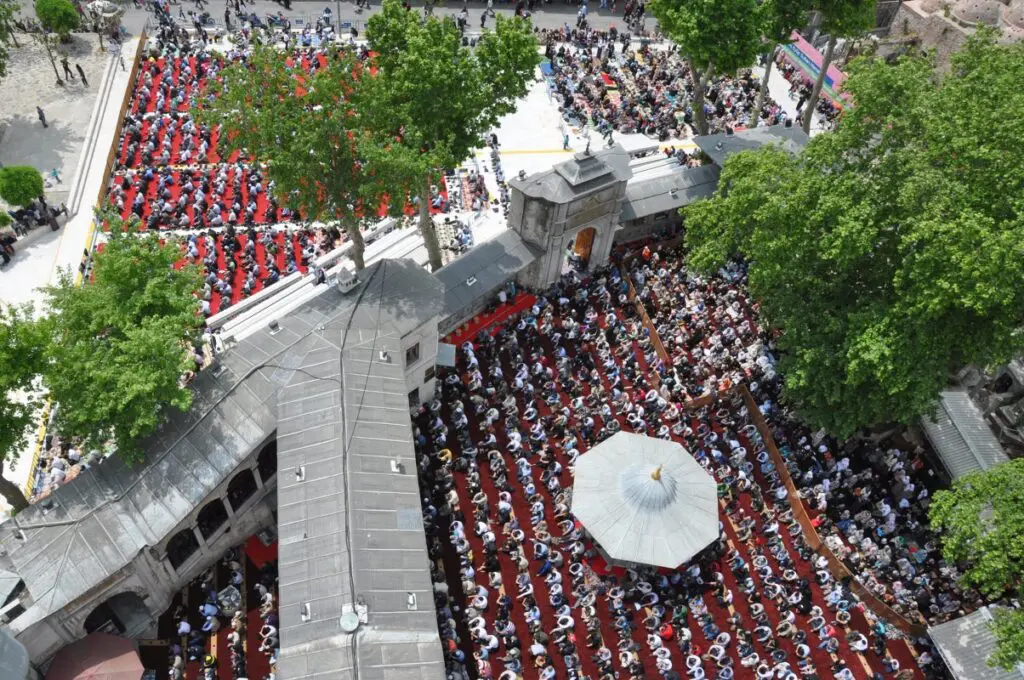
The Prayer Hall
The prayer hall of the Eyup Sultan Mosque is a sight to behold. Its grand dome and beautifully adorned interior create an atmosphere of serenity and devotion. The walls are adorned with intricate geometric patterns and Quranic verses, adding to the spiritual ambiance of the mosque. The mihrab, a niche indicating the direction of Mecca, is exquisitely designed, serving as a focal point for worshippers.
Dome and Structural Design
The grand dome of the prayer hall is an architectural wonder, symbolizing the heavens above. Its construction reflects the advanced engineering techniques of the Ottoman period, with a symmetrical design that enhances acoustics and aesthetics. The dome’s interior is adorned with intricate patterns, adding to the hall’s serene atmosphere.
Interior Adornments
Inside the prayer hall, the walls are a canvas of geometric patterns and Quranic verses. These adornments are not merely decorative; they embody the spiritual essence of the mosque. The meticulous craftsmanship is evident in every detail, inviting worshippers to reflect on the divine as they engage in prayer.
Significance of the Mihrab
The mihrab is a focal point within the prayer hall, guiding worshippers in their prayers towards Mecca. Its design is both functional and symbolic, with intricate decorations that highlight its importance. The mihrab’s presence underscores the mosque’s role as a place of spiritual guidance and reflection.
The Minarets
The mosque is flanked by two towering minarets that reach towards the sky. These minarets not only serve as architectural features but also play a practical role in calling the faithful to prayer. Their slender design and decorative elements are a testament to the architectural brilliance of the Ottoman period.
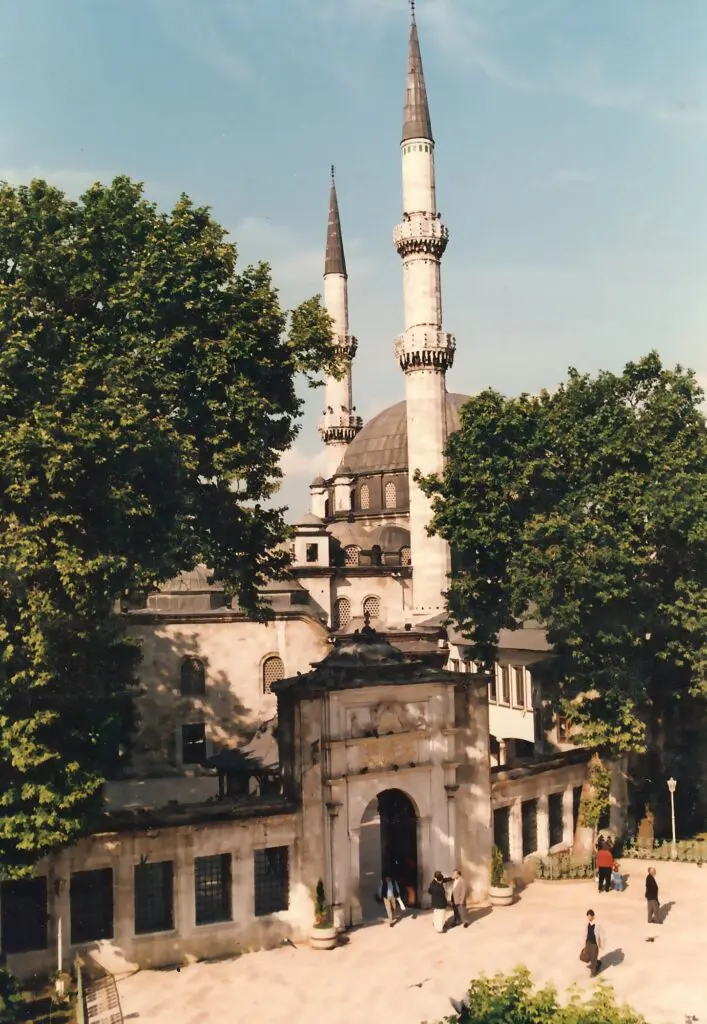
Architectural Significance
The minarets of the Eyup Sultan Mosque are emblematic of Ottoman architectural innovation. Their slender, towering structures are designed to be both functional and aesthetically pleasing. The minarets are adorned with decorative elements that reflect the artistic flair of the era.
Call to Prayer
Functionally, the minarets serve a crucial role in the Islamic tradition. From their heights, the call to prayer (adhan) resonates across the surrounding area, inviting the faithful to gather for worship. This auditory tradition is an integral aspect of the mosque’s daily life, reinforcing its spiritual significance.
Symbol of Devotion
Beyond their practical function, the minarets are symbols of devotion and spiritual aspiration. Their towering presence is a visual reminder of the mosque’s role as a beacon of faith, drawing individuals towards a life of religious observance and community.
The Cultural Significance of Eyup Sultan Mosque
The Eyup Sultan Mosque holds immense cultural and spiritual significance for both the people of Turkey and the broader Muslim community. It has been a place of pilgrimage for centuries, drawing visitors from far and wide who seek to pay their respects to Abu Ayyub al-Ansari and experience the spiritual aura of the mosque.
Pilgrimage and Traditions
For many Muslims, visiting the Eyup Sultan Mosque is a deeply spiritual experience. Pilgrims come to offer prayers, seek blessings, and connect with the rich history of Islam. The mosque is particularly popular during religious festivals and significant Islamic events, when it comes alive with vibrant celebrations and gatherings.
Spiritual Journey
Visiting the Eyup Sultan Mosque is often seen as a spiritual journey. Pilgrims embark on this journey to deepen their faith, seeking blessings and guidance. This pilgrimage is a testament to the mosque’s enduring significance in the lives of Muslims worldwide.
Festival Celebrations
During religious festivals, the mosque becomes a hub of activity and celebration. Events such as Ramadan and Eid are marked by special prayers, communal meals, and cultural festivities. These celebrations highlight the mosque’s role as a center of religious and cultural life in Istanbul.
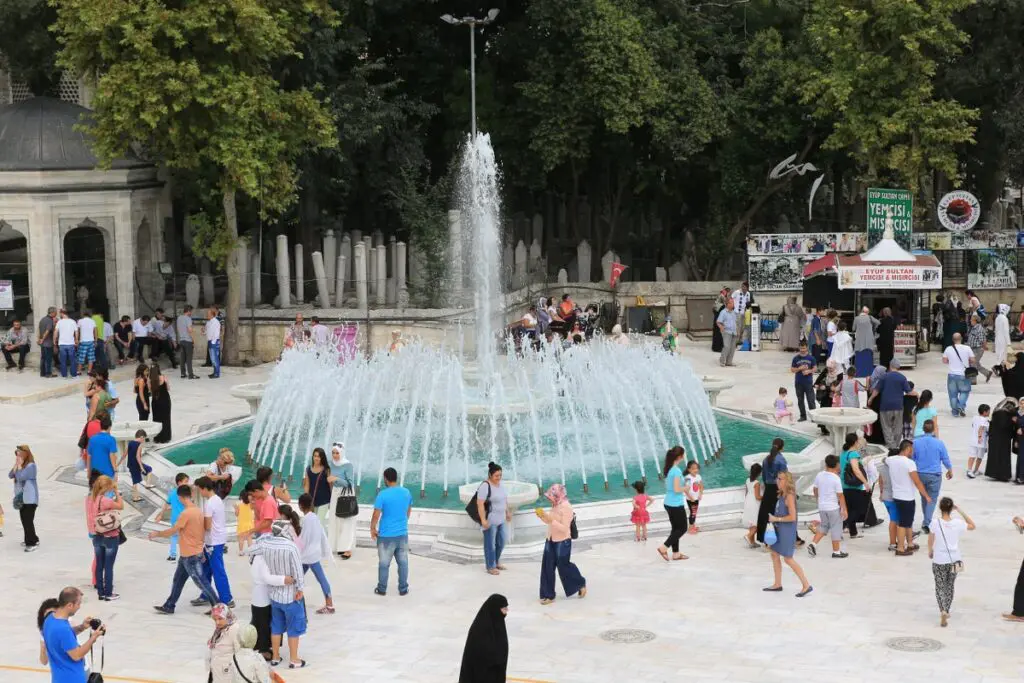
Cultural Exchange
The influx of pilgrims and visitors from diverse backgrounds fosters a rich cultural exchange. The mosque becomes a melting pot of traditions, languages, and customs, enhancing its cultural significance. This exchange enriches the experience for all who visit, promoting understanding and unity.
The Role in Ottoman Ceremonies
Throughout history, the Eyup Sultan Mosque played a significant role in Ottoman ceremonies and rituals. It was the site of important state events, including the enthronement ceremonies of Ottoman sultans. The mosque’s historical significance is intertwined with the legacy of the Ottoman Empire, making it a symbol of both religious devotion and imperial power.
State Ceremonies
The mosque was a venue for various state ceremonies, reflecting its importance in Ottoman society. These ceremonies included the enthronement of sultans, where new rulers were presented to the public. Such events underscored the mosque’s role as a symbol of both spiritual and political authority.
Imperial Legacy
The Eyup Sultan Mosque’s connection to the Ottoman Empire’s imperial legacy is profound. It served as a backdrop for events that shaped the course of the empire’s history. This legacy is preserved in the mosque’s architecture and traditions, offering visitors a glimpse into a bygone era.
Religious and Political Symbolism
The mosque’s dual role as a religious and political symbol underscores its unique place in history. It represents the fusion of faith and governance that characterized the Ottoman Empire, highlighting the intertwined nature of religion and state in that era.
Eyup Sultan Mosque in Modern Times
Today, the Eyup Sultan Mosque continues to be a vibrant center of worship and cultural heritage. It stands as a testament to the enduring legacy of Islamic architecture and the rich history of Istanbul. The mosque is open to visitors of all faiths, welcoming those who wish to explore its beauty and learn about its historical significance.
Preservation and Restoration
Over the years, efforts have been made to preserve and restore the Eyup Sultan Mosque, ensuring that its architectural beauty and historical significance are maintained for future generations. Restoration projects have focused on preserving the intricate tile work, calligraphy, and structural elements of the mosque.
Ongoing Restoration Efforts
The preservation of the Eyup Sultan Mosque is an ongoing process. Restoration projects are carefully planned to maintain the mosque’s historical integrity while addressing the wear and tear of time. These efforts involve meticulous attention to detail, ensuring that the mosque’s beauty is preserved for future generations.
Challenges and Innovations
Restoration efforts face challenges, including balancing historical accuracy with modern conservation techniques. Innovations in preservation technology have enabled restorers to address these challenges effectively. By combining traditional craftsmanship with modern methods, the mosque’s architectural splendor is safeguarded.
Community Involvement
The preservation of the mosque is a community endeavor. Local and international organizations collaborate to support restoration efforts, emphasizing the mosque’s significance as a cultural and historical treasure. This community involvement fosters a sense of ownership and pride among those connected to the mosque.
A Symbol of Unity
The Eyup Sultan Mosque serves as a symbol of unity, bringing together people from diverse backgrounds and cultures. It is a place where individuals can come together in prayer, reflection, and celebration, fostering a sense of community and shared spirituality.
Interfaith Engagement
The mosque’s open-door policy encourages interfaith engagement and understanding. Visitors from various religious backgrounds are welcomed to explore its history and architecture, promoting dialogue and mutual respect. This engagement enhances the mosque’s role as a bridge between cultures.
Community Gatherings
The mosque is a focal point for community gatherings, offering a space for social and cultural activities. These gatherings foster a sense of belonging and community spirit, strengthening social bonds. The mosque’s role as a community hub underscores its importance beyond its religious functions.
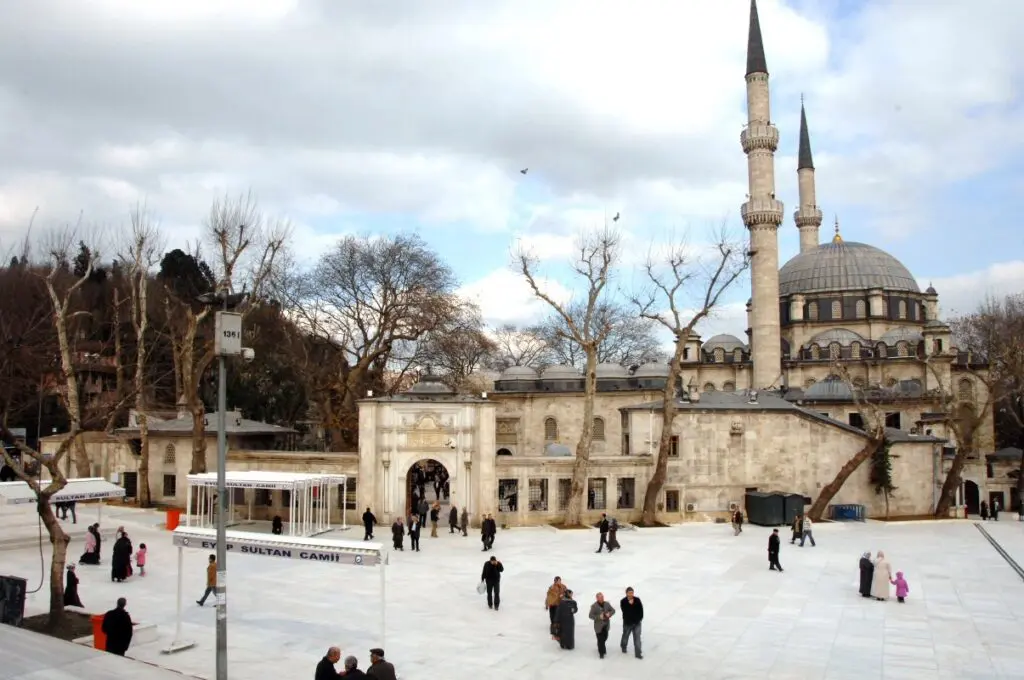
Promoting Peace and Understanding
As a symbol of unity, the Eyup Sultan Mosque promotes peace and understanding among diverse groups. Its inclusive atmosphere encourages visitors to learn about Islam and its cultural heritage, fostering a spirit of tolerance and coexistence. This mission aligns with the mosque’s historical legacy as a place of spiritual and cultural exchange.
Conclusion
The Eyup Sultan Mosque is more than just a place of worship; it is a testament to the rich history, architectural brilliance, and cultural significance of Istanbul. As visitors explore its halls and courtyards, they are transported back in time, experiencing the spiritual and historical legacy of this remarkable mosque. Whether you are a history enthusiast, a spiritual seeker, or a curious traveler, the Eyup Sultan Mosque offers a profound and enriching experience that leaves a lasting impression on all who visit.
FAQs
1. Where is Eyüp Sultan Mosque located?
Eyüp Sultan Mosque is in the Eyüp district of Istanbul, Turkey, near the Golden Horn.
2. Who is buried at Eyüp Sultan Mosque?
The mosque is the resting place of Abu Ayyub al-Ansari, a companion of Prophet Muhammad.
3. What are the visiting hours of the mosque?
The mosque is open daily from early morning until late evening, except during prayer times.
4. Is there an entrance fee to visit the mosque?
No, entry to Eyüp Sultan Mosque is free for all visitors.
5. What is the significance of the mosque?
It is one of Istanbul’s holiest sites, attracting many pilgrims and tourists for its spiritual importance.
6. Can non-Muslims visit the mosque?
Yes, non-Muslims can visit outside prayer times while respecting dress codes and mosque etiquette.
7. What is the best time to visit?
Early mornings or late afternoons are ideal to avoid crowds and enjoy a peaceful visit.
8. Is there a dress code for visitors?
Yes, modest clothing is required. Women should cover their heads, and both men and women should wear long clothing.
9. How can I reach Eyüp Sultan Mosque?
You can reach the mosque by tram, bus, taxi, or a scenic ferry ride along the Golden Horn.
10. Are there any nearby attractions?
Yes, visitors can explore Pierre Loti Hill, the Eyüp Cemetery, and the Golden Horn waterfront.
11. Is photography allowed inside the mosque?
Yes, photography is allowed, but visitors should be respectful and avoid disturbing worshippers.
12. Are there guided tours available?
Yes, some tour operators offer guided tours that include Eyüp Sultan Mosque and surrounding historical sites.
13. Can I perform prayers at the mosque?
Yes, visitors are welcome to pray inside the mosque during designated prayer times.
14. Is there wheelchair access?
Yes, the mosque has wheelchair access, but some surrounding areas may have uneven terrain.
15. Are there facilities like restrooms and ablution areas?
Yes, the mosque provides restrooms and ablution facilities for worshippers.
16. What is the history of the mosque?
Built in 1458, it was the first mosque constructed by the Ottomans after the conquest of Constantinople.
17. Is there a market or shops nearby?
Yes, the area around the mosque has traditional shops selling Islamic items, souvenirs, and local food.
18. What special events take place at the mosque?
Religious celebrations, Friday prayers, and special Islamic events like Ramadan and Eid prayers are held here.
19. Can visitors attend Friday prayers?
Yes, but it can be very crowded, so arriving early is recommended.
20. Are there any restrictions for visitors?
Visitors should remain quiet, dress modestly, and avoid entering during prayer times unless they are worshipping.
21. Is there a specific prayer schedule for the mosque?
Yes, Eyüp Sultan Mosque follows the standard Islamic prayer schedule, with five daily prayers. Times vary based on the season.
22. Are children allowed inside the mosque?
Yes, children are welcome, but parents should ensure they remain quiet and respectful during prayers.
23. What is the architectural style of the mosque?
The mosque features classic Ottoman architecture with a large central dome, intricate tilework, and beautiful calligraphy.
24. Can I visit the tomb of Abu Ayyub al-Ansari?
Yes, the tomb is located within the mosque complex and is open to visitors for prayers and reflection.
25. Are there any special religious customs to observe when visiting?
Visitors should remove their shoes before entering, dress modestly, and avoid loud conversations inside the mosque.

